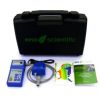Eno Scientific Well Watch 700 Water Level Monitor
Features
- Measures water levels using sound waves, no risk of contamination
- Complete well management and control, providing real time asset data
- Simple external installation, no well decommissioning (prior or during)
- Free ground shipping
- Expedited repair and warranty service
- Lifetime technical support
- More
Overview
The Eno Scientific Well Watch 700 can measure water levels in commercial water wells with levels down to 7000 ft, up to 30" diameter, and with top mount turbine or submersible pumps. Operating on low frequency sound waves, there is no need for equipment to be lowered down into the casing. The versatile sound waves can travel past obstructions, installed well equipment and around corners. The Well Watch boasts an intuitive software that monitors well conditions and automatically adjusts to maintain the most accurate readings.
Mechanics
The Eno Scientific 700 was designed to be a well management hub and provides users with static, drawdown, recovery and flow data at an interval chosen by the user. The Well Watch 700 boasts two independently programmable relays for pump control and remote alarms. There are multiple outputs to choose from including RS232, RS485, 4-20mA, 0-5V, SDI-12 and Ethernet to communicate with any pre-existing system. An internal data logger allows it to operate as a stand alone system or a backup in case of communication loss, logging up to 25 million data points. Collected data can be accessed over the USB connection or by removing the SD card.
In The News
Lake Erie Volunteer Science Network: Building Trust in Citizen Science Programs
Citizen science programs have popped up across the United States, focusing on connecting local communities with nearby water resources and building a trustworthy data pool over the sampling period. While commonly utilized as a means of ensuring that large watersheds or lake regions are adequately sampled, the credibility and success of such programs have been called into question. [caption id="attachment_38996" align="alignnone" width="940"] HRWC volunteers measure stream velocity across a subsection of Woods Creek, a tributary of the Huron River near Belleville, Michigan. Stream velocity measurements can be combined with water level measurements to calculate stream flow and chemical parameter loads.
Read MoreMonitoring Lake Erie’s Eastern Basin: Building Long-Term Data and Real-Time Public Solutions
In the eastern basin of Lake Erie, off the coast of Dunkirk, New York, a data buoy collects valuable water quality, weather, and wave data that inform residents and regulatory groups of conditions on the water. Since 2011, Buffalo State University’s Great Lakes Center has maintained and operated the Dunkirk buoy with funding from the Great Lakes Observing System (GLOS) and field support from the NYSDEC Lake Erie Fisheries Research Unit. [caption id="attachment_38976" align="aligncenter" width="940"] The Dunkirk Buoy viewed from the research vessel after being deployed in early spring.
Read MoreSonTek CastAway-CTD Meter Review
Lightweight and easy to use, the SonTek CastAway offers a convenient 3-in-1 solution for measuring conductivity, temperature, and depth profiles. At a 5 Hz sampling rate, the CastAway is designed for up to 1 m/s free-fall through the water column. With fast response and accurate conductivity, temperature, and depth measurements, the CastAway is ideal for thermocline and halocline profiling. The unit also reports salinity and speed of sound. [caption id="attachment_38732" align="alignnone" width="940"] Environmental scientist, Katelyn Kubasky, holding the SonTek CastAway in front of the pond at the Fondriest Center for Environmental Studies.
Read More








